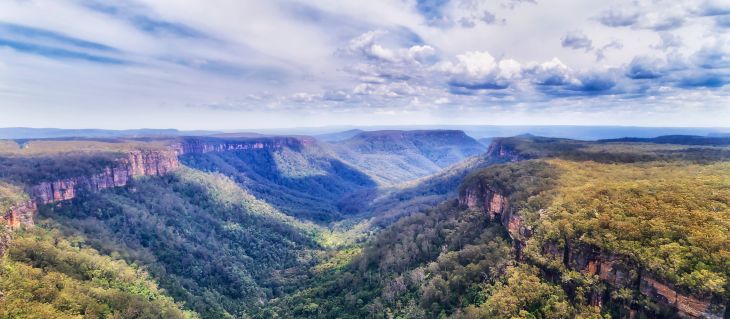
The view from Mount Talaterang takes in other mesa landforms. Photo: WWF Australia
By our count, there are now 23 fenced safe havens across Australia, and the number has been growing in recent years.
These sites work. But they require ongoing human input. You have to fence the land, make sure it stays fenced, and control for feral predators. When funding runs out, the havens can fall into disrepair and predators may eventually break back in.
We need supplementary approaches to add to our rewilding toolkit – outside the fences.
The reason we began investigating mesas is their shape. By definition, a mesa is an isolated flat-topped landform, elevated from its surrounding landscape by steep sides. The Spanish word “mesa” translates to “table” in English, reflecting their distinctive shape. But don’t be confused – a mesa is different to a tableland such as the Atherton Tablelands in northern Queensland. A mesa is generally smaller and stands alone.
We theorised the steep, largely vegetation-free sides of a mesa could act as natural barriers, slowing down fox and cat incursions. Better still, the isolation of these landforms might give extra protection to species vulnerable to fire.
Luckily for us, these landforms aren’t reserved for lonely cowboys on horseback and an Ennio Morricone soundtrack. We scoured satellite images and found 91 mesas just in New South Wales, each with a flat top larger than ten hectares.
Sky-islands: putting mesas to the test
To test our theories, we chose Mount Talaterang. This remote mountain in Morton National Park has a flat top of 317 hectares, making it one of the largest mesas we found in New South Wales.
We set up cameras on top of the mesa as well as in the surrounding bushland at the bottom of the steep slopes and gathered four months of data.
The results were exciting. As we had hoped, the top of the mesa was almost entirely free of invasive mammals. There were no foxes or rabbits. Feral cats were present atop the mesa, but in significantly lower numbers than in the lowlands. Better still, we spotted higher numbers of small native mammals such as antechinus species and spotted-tailed quoll atop the mesa than in the bush below.
By contrast, we spotted far more invasive mammals in the bush below the mesa. Specifically, we sighted foxes 633 times, and cats 338 times, whereas no foxes were recorded on the mesa, and we recorded only 5 sightings of cats.
On the mesa, we captured 26 instances of antechinuses and 20 of quolls, but saw zero antechinus and only one quoll in the lowlands.
















